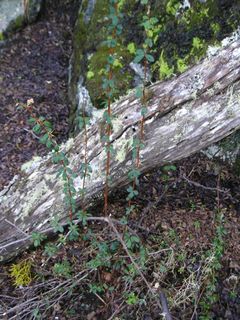Berberis buxifolia: Difference between revisions
No edit summary |
No edit summary |
||
| Line 1: | Line 1: | ||
{{SPlantbox | {{SPlantbox | ||
|genus=Berberis | |familia=Berberidaceae | ||
|genus=Berberis | |||
|species=buxifolia | |species=buxifolia | ||
|taxo_author=Lam. | |||
|common_name=Calafate | |||
|habit=shrub | |||
|Temp Metric=°F | |Temp Metric=°F | ||
|jumpin=If this plant info box on watering; zones; height; etc. is mostly empty you can click on the edit tab and fill in the blanks! | |jumpin=If this plant info box on watering; zones; height; etc. is mostly empty you can click on the edit tab and fill in the blanks! | ||
|image= | |image=Calafate-Berberis_buxifolia.jpg | ||
|image_width=240 | |image_width=240 | ||
}} | }} | ||
'''''Berberis buxifolia''''', common name the '''Magellan Barberry''', in [[Spanish language|Spanish]] '''Calafate''', is an evergreen shrub, with shiny [[Buxus|box]]-like leaves. The Calafate is native to the south of [[Argentina]] and [[Chile]] and is a symbol of [[Patagonia]]. | |||
The bush grows to a height of 1 - 1.5 m. It has many arching branches, each covered in many tripartite spines. The bush has many small yellow flowers in summer. Its edible blue-black [[berry|berries]] are harvested for [[jam]]s, but are eaten fresh too - a legend tells that anyone who eats a Calafate berry will be certain to return to Patagonia. | |||
The Calafate is grown commercially for its fruit, potential medical uses and as a garden plant or [[bonsai]]. Its wood is used to make a red [[dye]]. The [[cultivar]] ''Berberis buxifolia'' 'Nana' is widely available as a garden shrub, and is also used in commercial plantings as a low spiny hedge to discourage intruders, but it does not fruit. | |||
{{Inc| | {{Inc| | ||
Berberis buxifolia, Poir. (B. dulcís, Sweet). One to 3 ft.: branches brown, grooved; spines usually 3-parted, short: Lvs. cuneate, obovate or elliptic, ⅓-1 in. long: fls. solitary, on long pedicels, orange-yellow: fr. nearly globose, blackish purple. May. Chile to Strait of Magellan | Berberis buxifolia, Poir. (B. dulcís, Sweet). One to 3 ft.: branches brown, grooved; spines usually 3-parted, short: Lvs. cuneate, obovate or elliptic, ⅓-1 in. long: fls. solitary, on long pedicels, orange-yellow: fr. nearly globose, blackish purple. May. Chile to Strait of Magellan.—A very graceful, free-flowering shrub; one of the hardiest of the evergreen species; will stand the winter even N. if somewhat protected. | ||
}} | }} | ||
==Cultivation== | |||
===Propagation=== | |||
===Pests and diseases=== | |||
==Varieties== | |||
==Gallery== | |||
<gallery perrow=5> | |||
Image:Upload.png| photo 1 | |||
Image:Upload.png| photo 2 | |||
Image:Upload.png| photo 3 | |||
</gallery> | |||
[[ | ==References== | ||
<references/> | |||
*[[Standard Cyclopedia of Horticulture]], by L. H. Bailey, MacMillan Co., 1963 | |||
<!--- xxxxx *Flora: The Gardener's Bible, by Sean Hogan. Global Book Publishing, 2003. ISBN 0881925381 --> | |||
<!--- xxxxx *American Horticultural Society: A-Z Encyclopedia of Garden Plants, by Christopher Brickell, Judith D. Zuk. 1996. ISBN 0789419432 --> | |||
<!--- xxxxx *Sunset National Garden Book. Sunset Books, Inc., 1997. ISBN 0376038608 --> | |||
{{ | ==External links== | ||
*{{wplink}} | |||
{{stub}} | |||
__NOTOC__ | __NOTOC__ | ||
Revision as of 21:08, 5 February 2010
| Berberis buxifolia subsp. var. | Calafate | |||||||||||||||||||||||||||||||||||||||||||||||||||||||
|---|---|---|---|---|---|---|---|---|---|---|---|---|---|---|---|---|---|---|---|---|---|---|---|---|---|---|---|---|---|---|---|---|---|---|---|---|---|---|---|---|---|---|---|---|---|---|---|---|---|---|---|---|---|---|---|---|

|
|
| ||||||||||||||||||||||||||||||||||||||||||||||||||||||
| ||||||||||||||||||||||||||||||||||||||||||||||||||||||||
Berberis buxifolia, common name the Magellan Barberry, in Spanish Calafate, is an evergreen shrub, with shiny box-like leaves. The Calafate is native to the south of Argentina and Chile and is a symbol of Patagonia.
The bush grows to a height of 1 - 1.5 m. It has many arching branches, each covered in many tripartite spines. The bush has many small yellow flowers in summer. Its edible blue-black berries are harvested for jams, but are eaten fresh too - a legend tells that anyone who eats a Calafate berry will be certain to return to Patagonia.
The Calafate is grown commercially for its fruit, potential medical uses and as a garden plant or bonsai. Its wood is used to make a red dye. The cultivar Berberis buxifolia 'Nana' is widely available as a garden shrub, and is also used in commercial plantings as a low spiny hedge to discourage intruders, but it does not fruit.
| Standard Cyclopedia of Horticulture |
|---|
|
Berberis buxifolia, Poir. (B. dulcís, Sweet). One to 3 ft.: branches brown, grooved; spines usually 3-parted, short: Lvs. cuneate, obovate or elliptic, ⅓-1 in. long: fls. solitary, on long pedicels, orange-yellow: fr. nearly globose, blackish purple. May. Chile to Strait of Magellan.—A very graceful, free-flowering shrub; one of the hardiest of the evergreen species; will stand the winter even N. if somewhat protected.
|
Cultivation
Propagation
Pests and diseases
Varieties
Gallery
-
photo 1
-
photo 2
-
photo 3
References
- Standard Cyclopedia of Horticulture, by L. H. Bailey, MacMillan Co., 1963
External links
- w:Berberis buxifolia. Some of the material on this page may be from Wikipedia, under the Creative Commons license.
- Berberis buxifolia QR Code (Size 50, 100, 200, 500)
